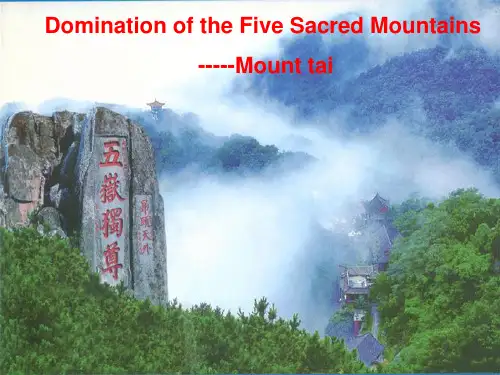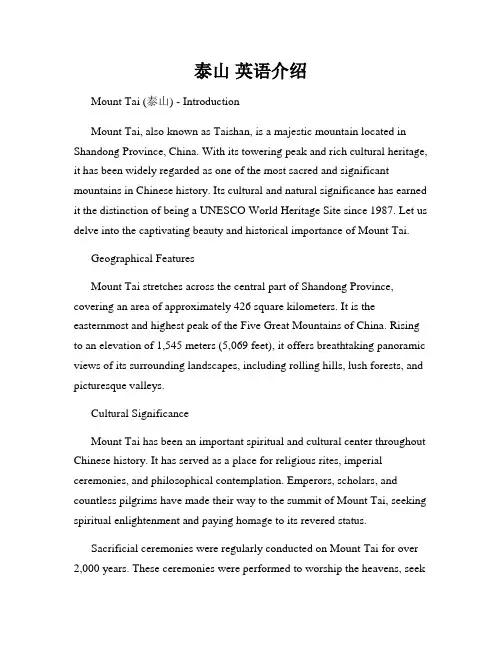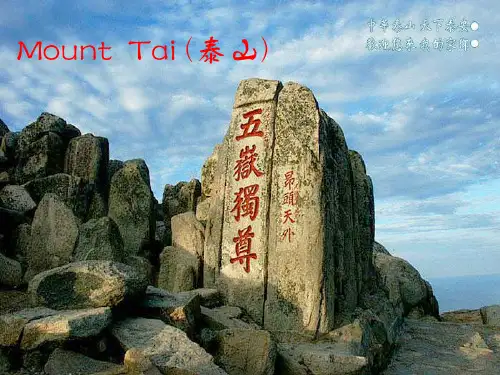东岳泰山(英语ppt)
- 格式:ppt
- 大小:10.97 MB
- 文档页数:36






泰山英语介绍Mount Tai (泰山) - IntroductionMount Tai, also known as Taishan, is a majestic mountain located in Shandong Province, China. With its towering peak and rich cultural heritage, it has been widely regarded as one of the most sacred and significant mountains in Chinese history. Its cultural and natural significance has earned it the distinction of being a UNESCO World Heritage Site since 1987. Let us delve into the captivating beauty and historical importance of Mount Tai.Geographical FeaturesMount Tai stretches across the central part of Shandong Province, covering an area of approximately 426 square kilometers. It is the easternmost and highest peak of the Five Great Mountains of China. Rising to an elevation of 1,545 meters (5,069 feet), it offers breathtaking panoramic views of its surrounding landscapes, including rolling hills, lush forests, and picturesque valleys.Cultural SignificanceMount Tai has been an important spiritual and cultural center throughout Chinese history. It has served as a place for religious rites, imperial ceremonies, and philosophical contemplation. Emperors, scholars, and countless pilgrims have made their way to the summit of Mount Tai, seeking spiritual enlightenment and paying homage to its revered status.Sacrificial ceremonies were regularly conducted on Mount Tai for over 2,000 years. These ceremonies were performed to worship the heavens, seekblessings for prosperity and peace, and show reverence to the mountain itself. The rituals and customs associated with Mount Tai have greatly influenced Chinese culture, including art, literature, and even the Chinese calendar.Historical SignificanceThe historical significance of Mount Tai can be traced back to ancient times. It is believed that the mountain was first climbed by the legendary emperor, Huangdi, who is considered the ancestor of the Chinese people. Since then, Mount Tai has attracted many influential figures throughout history, such as Confucius and countless emperors from different dynasties.Confucius, the famous philosopher, visited Mount Tai in the 6th century BC and regarded it as a place of great moral importance. He emphasized the concept of "self-improvement" and sought inspiration from the majestic scenery and serene atmosphere of the mountain.During the imperial era, emperors would undertake arduous journeys to Mount Tai to conduct the "Fengshan" ritual, symbolizing the unity between heaven and earth. This ritual involved the offering of sacrifices and prayers to ensure good governance and harmony for the empire.Tourism and AttractionsToday, Mount Tai continues to be a popular tourist destination, attracting visitors from both within China and around the world. The mountain offers various hiking trails to its peak, ranging in difficulty and length. As visitors ascend, they can enjoy the picturesque landscapes that showcase the wonders of nature.Key attractions on Mount Tai include the magnificent Jade Emperor Peak, the South Heaven Gate, the Red Gate Palace, and the Eighteen Bends. Each of these sites possesses its own unique beauty and historical significance, providing visitors with a rich cultural experience.The sunrise from the summit of Mount Tai is a breathtaking spectacle that should not be missed. Witnessing the first light of day illuminating the surrounding valleys and peaks is a truly magical and unforgettable experience.ConclusionMount Tai stands as a testament to the grandeur of nature and the rich tapestry of Chinese history and culture. Its towering presence and profound significance have captivated the hearts of countless individuals for centuries. Whether you seek spiritual enlightenment, historical exploration, or simply a chance to admire the beauty of nature, a visit to Mount Tai promises an awe-inspiring journey you will cherish forever.。





Mount Tai: The Sacred Mountain ofthe EastRising majestically in the eastern part of Shandong Province, Mount Tai (also known as Tai Shan) stands not only as a geographical landmark but as a spiritual and cultural icon deeply rooted in Chinese history and mythology. Designated as a UNESCO World Heritage Site in 1987, Mount Tai is one of the Five Great Mountains of China and holds a special place in the hearts of the Chinese people as the "First Mountain under Heaven."Historical Significance and Cultural LegacyMount Tai has long been considered a sacred site, a place where emperors and commoners alike have come to offer sacrifices and prayers to the gods. Its significance dates back thousands of years to ancient times when it was believed to be the dwelling place of deities. The mountain is particularly revered for its association with the East, symbolizing birth and renewal in Chinese cosmology.Throughout history, Mount Tai has been the site of imperial sacrifices and coronations, with emperors from different dynasties ascending the mountain to perform ceremonies known as Feng Shan (封禅) and Si Shan (祀山).These rituals were meant to communicate with the heavens and ensure the prosperity and stability of the empire. More than 70 emperors are recorded to have made pilgrimages to Mount Tai, leaving behind countless inscriptions, steles, and monuments that bear witness to their visits.Natural Beauty and Scenic WondersMount Tai is not merely a place of historical and religious importance; it is also a breathtaking landscape filled with natural beauty. The mountain reaches an elevation of 1,545 meters (5,069 feet) at its peak, Jade Emperor Peak (玉皇顶), offering panoramic views of the surrounding countryside. The journey up the mountain is as much a part of its allure as its summit, with winding paths leading through lush forests, past cascading waterfalls, and by ancient temples and pavilions.Among the many scenic spots on Mount Tai are the Heavenly Southern Gate (南天门), the Eighteen Bends (十八盘), and the Dai Miao Temple at the foot of the mountain. The Eighteen Bends, a series of steep steps, is particularly challenging yet rewarding, culminating in stunning vistas from the Heavenly Southern Gate.Spiritual and Philosophical ConnectionsMount Tai has played a significant role in the development of Chinese thought and philosophy. It is mentioned in ancient texts such as the "Book of Documents" and the "Classic of Mountains and Seas." Confucius himself is said to have climbed Mount Tai, famously declaring, "Once one has seen the sunrise from Mount Tai, there is no need to see another sunrise."For Taoists, Mount Tai is one of the seven sacred mountains, and it is believed that the mountain possesses healing properties and the power to grant wishes. Pilgrims and visitors often make offerings at various shrines and temples along the way, seeking blessings and good fortune.ConclusionMount Tai continues to attract millions of visitors each year, drawn by its historical legacy, natural splendor, and spiritual significance. Whether one approaches it as a tourist, a historian, or a seeker of the divine, Mount Tai offers an unforgettable experience that resonates with the very essence of Chinese culture and identity.。